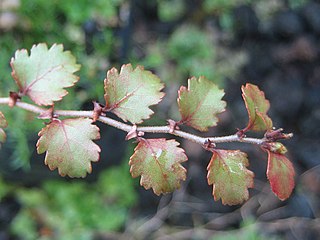
Antarctic flora are a distinct community of vascular plants which evolved millions of years ago on the supercontinent of Gondwana. Presently, species of Antarctica flora reside on several now separated areas of the Southern Hemisphere, including southern South America, southernmost Africa, New Zealand, Australia, and New Caledonia. Joseph Dalton Hooker was the first to notice similarities in the flora and speculated that Antarctica had served as either a source or a transitional point, and that land masses now separated might formerly have been adjacent.
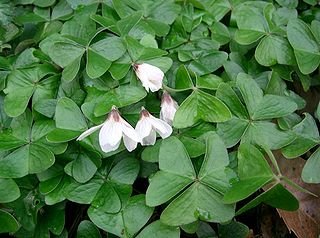
Oxalis is a large genus of flowering plants in the wood-sorrel family Oxalidaceae, comprising over 550 species. The genus occurs throughout most of the world, except for the polar areas; species diversity is particularly rich in tropical Brazil, Mexico, and South Africa.
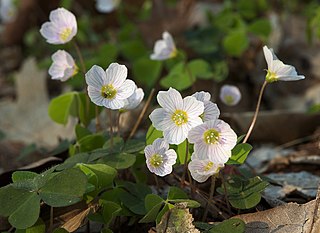
Oxalis acetosella, the wood sorrel or common wood sorrel, is a rhizomatous flowering plant in the family Oxalidaceae, common in most of Europe and parts of Asia. The specific epithet acetosella refers to its sour taste. The common name wood sorrel is often used for other plants in the genus Oxalis. In much of its range it is the only member of its genus and hence simply known as "the" wood sorrel. While common wood sorrel may be used to differentiate it from most other species of Oxalis, in North America, Oxalis montana is also called common wood sorrel. It is also known as Alleluia because it blossoms between Easter and Pentecost, when the Psalms which end with Hallelujah are sung.
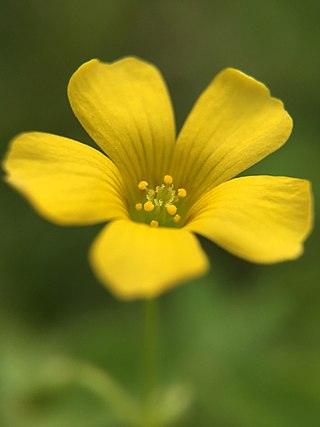
Oxalis corniculata, the creeping woodsorrel, procumbent yellow sorrel or sleeping beauty, is a somewhat delicate-appearing, low-growing herbaceous plant in the family Oxalidaceae. It resembles the common yellow woodsorrel, Oxalis stricta.
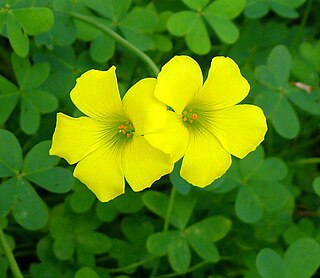
Oxalis pes-caprae is a species of tristylous yellow-flowering plant in the wood sorrel family Oxalidaceae. Oxalis cernua is a less common synonym for this species. Some of the most common names for the plant reference its sour taste owing to oxalic acid present in its tissues. Indigenous to South Africa, the plant has become a pest plant in different parts of the world that is difficult to eradicate because of how it propagates through underground bulbs.
Nuytsia is a peer-reviewed scientific journal published by the Western Australian Herbarium. It publishes papers on systematic botany, giving preference to papers related to the flora of Western Australia. Nearly twenty percent of Western Australia's plant taxa have been published in Nuytsia. The journal was established in 1970 and has appeared irregularly since. Kevin Thiele and Juliet Wege have been in the editorial committee.

Medicago lupulina, commonly known as black medick, nonesuch, or hop clover, is a plant of dry grassland belonging to the legume or clover family. Plants of the genus Medicago, or bur clovers, are closely related to the true clovers (Trifolium) and sweet clover (Melilotus). Like the true clovers, black medick has three leaflets and a small, yellow flower closely resembling those of lesser trefoil. Black medick belongs to the same genus as alfalfa.

Oxalis violacea, the violet wood-sorrel, is a perennial plant and herb in the family Oxalidaceae. Oxalis species are also known as sour grass, sour trefoil, and shamrock.

Austrostipa is a primarily Australian genus of plants in the grass family, commonly called speargrass.

Oxalis triangularis, commonly called false shamrock, is a species of perennial plant in the family Oxalidaceae. It is native to several countries in southern South America. This woodsorrel is typically grown as a houseplant but can be grown outside in USDA climate zones 8a–11, preferably in light shade.
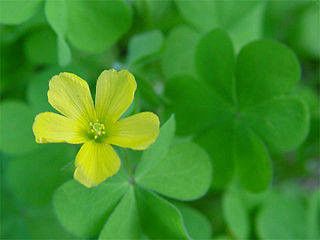
Oxalis albicans, commonly known as radishroot woodsorrel, is North American species of perennial herbs in the woodsorrel family. It is widespread in Mexico and the southwestern United States.

Oxalis purpurea is a species of flowering plant in the woodsorrel family known by the common name purple woodsorrel. It is native to southern Africa, including South Africa, but it is known on most continents as an introduced species. It is cultivated as an ornamental plant. This perennial herb grows from bulbs and produces a few basal leaves and flowers. The leaf is made up of three hairy leaflets of various shapes which are dark green in color, turning streaked and spotted with brown as they dry. The solitary flower arises on a stemlike peduncle and has five petals which may exceed two centimeters in length. The flower may be white to pink or purple-red.

Oxalis glabra is a member of the wood-sorrel family, Oxalidaceae. It is only one of the 800 total species belonging to this family. The plant is commonly known as finger-leaf due to its trifoliate leaf structure. This trifoliate structure can be seen in variations throughout all members of the genus Oxalis. However, the particularly narrow leaflets of the glabra plant look more like fingers rather than a common clover. The plant is native to South Africa and can be found carpeting the ground of woodlands and bushlands.
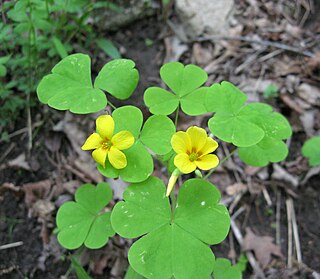
Oxalis illinoensis, the Illinois woodsorrel, is a species of flowering plant in the woodsorrel family (Oxalidaceae). It is endemic to the United States, where it found in Illinois, Indiana, Kentucky, and Tennessee. The limits of the range of this species are unclear due to its similarity to Oxalis grandis, with which there has been confusion.
The Botany of Fuegia, the Falklands, Kerguelen's Land, Etc. is a description of the plants discovered in these islands during the Ross expedition written by Joseph Dalton Hooker and published by Reeve Brothers in London between 1845 and 1847. Hooker sailed on HMS Erebus as assistant surgeon. It was the second in a series of four Floras in the Flora Antarctica, the others being the Flora of Lord Auckland and Campbell's Islands (1843-1845), the Flora Novae-Zelandiae (1851–1853), and the Flora Tasmaniae (1853–1859). They were "splendidly" illustrated by Walter Hood Fitch.

Acacia tenuissima, commonly known as narrow-leaved wattle, broom wattle, minyana, slender mulga or slender wattle, is a shrub belonging to the genus Acacia and the subgenus Juliflorae endemic to temperate and tropical areas of Australia. Indigenous Australians the Kurrama peoples know the plant as Janangungu and the Banyjima know it as Murruthurru.
Joy Thompson was an Australian botanist. Her main research areas were taxonomy and Myrtaceae.
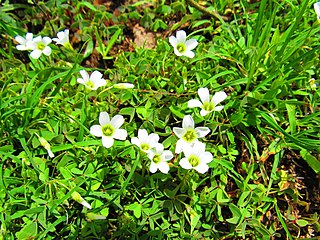
Oxalis alpina is a herbaceous perennial plant also known by its common name alpine woodsorrel. It is a species belonging to the genus Oxalis.O. alpina is found in North America and Central America from Guatemala to the southwestern United States.

Oxalis rubens is a small herbaceous plant found in coastal areas of Australia and New Zealand. Branches are erect or ascending, up to 35 cm long, of a dull red-brown colour. The specific epithet rubens is derived from Latin, meaning reddish in colour.
















